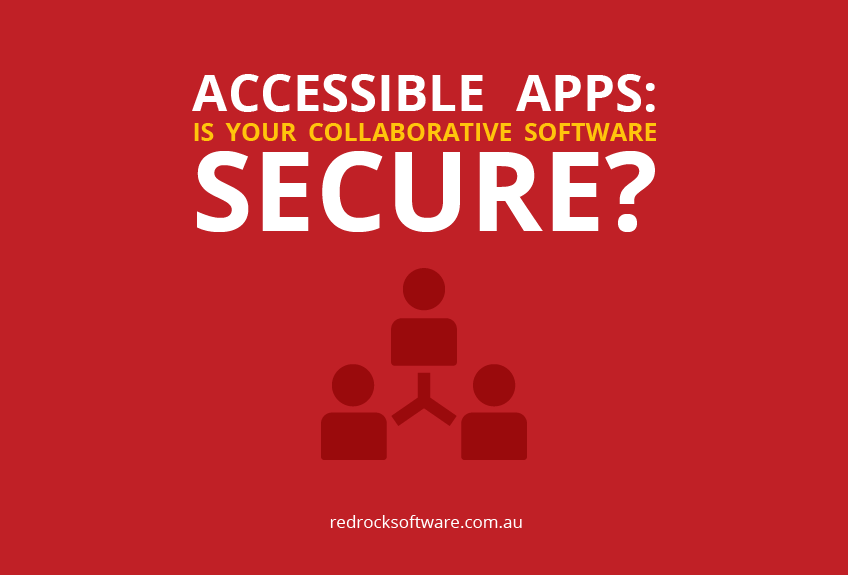
30 Nov Accessible Apps: Is Your Collaborative Software Secure?
Connecting your employees via new software and services can make for a more productive and efficient workplace.
From BYOD policies, to eLearning options, digital apps are becoming more commonplace. But there are issues associated with adopting new internal systems.
Many businesses cite security as a concern when it comes to implementing new apps and software within their infrastructures.
“Costs of data loss and theft can be in the millions, covering direct business losses, loss of intellectual property and business intelligence, audit and regulatory fines, compliance remediation costs and significantly – the loss of customer trust, reputation and brand equity.”
– Enterprise Architects: ‘Top Five Security Concerns Facing Enterprise’
BYOD may seem like a smart and forward thinking business policy, until an employee leaves a tablet computer containing sensitive data on the bus.
It’s understandable that many businesses are slow to implement new technologies. For many, it seems that caution is the watchword.
Securing Your Investment
We all know that custom web apps, new software and services, and implementing new technologies costs time and money.
It’s important that your investment has a significant return in terms of employee engagement and satisfaction. But a key consideration early on has to be security.
There are many policies that you can use to avoid embarrassing human error.
Let’s focus briefly on secure BYOD policies.
“…the advantages of BYOD are well-understood, but without the right policy in place it can also come at significant risk to corporate data. Lost or stolen devices could provide a backdoor direct into your computer network that can then be exploited by criminals, while malfunctioning devices create a further risk to data security.”
– Chloe Green: ‘Six Tips for Building a 2015-Proof BYOD Policy’
As Chloe Green points out, BYOD policies have several immediate security concerns. But this can be managed by an effective overarching strategy:
- Register devices
- On device security (Pass code before data can be accessed)
- Use a VPN
BYOD makes sense in terms of logistics. Employees using the devices they already own and know well makes for a more efficient workforce.
If you implement clear guidelines, and enforce them too, you’ll get the benefits of BYOD policies, whilst maintaining network security for your business.
Securing Collaborative Software
If you’re using out of the box software options then the best approach is to research what other businesses in your industry are using.
There’s plenty to choose from. Google has several tools to aid collaboration within a business, and there’s Dropbox too, alongside many more.
The big brand names are reliable when it comes to data security, but again you need to watch out for human error.
But the most important aspect of your business security is knowing what tools and software your employees are using:
“As different cloud tools grow in popularity, so do the security risks – especially as these tools are often used by employees without the consent or even knowledge of the head of the business.”
– Erkan Kahraman: ‘Avoid the Pitfalls of Online Collaboration Tools’
In this free for all digital world, you need to closely monitor what’s being done in your name. Employees will use the technology that best suits their approach, and this isn’t necessarily the same software that your business sanctions.
Erkan further states:
“In the context of cloud tools and online collaboration, IT security could be described as a house built on three pillars: trust; assurance; and protecting your data with the right software.”
That’s the key. ‘The right software.’ You need to be in control of your business, and the tools it uses. The pillars that Erkan considers aren’t in place for all software options. So, consider the technology that your business uses in this light.
Still feel secure? It’s highly probable that your employees are inadvertently cutting corners, and making your business less secure in the process.
Peace of Mind
That’s all anyone wants. Reassurance, the knowledge that their business is safe, secure, and policed efficiently.
The best approach is to talk with your employees. Tell them the risks and dangers associated with unapproved software, provide strict guidelines, and monitor the tools they use.
The balance comes from allowing your employees the freedom to work autonomously, choosing the software that suits them best, and making sure that your business and its data is secure.
There’s no quick security option for collaborative software. But what there does need to be is a consistent and enforced policy. It has to be known and understood by your employees.
BYOD is a great and forward thinking approach. But employees must know that when they use a personal smartphone to access sensitive business data, it becomes a security issue.
Conclusion
Collaborative software and cloud based options are excellent tools that can be used to ensure that a business runs more efficiently. They provide scope for better connectivity, and they simplify communication, too.
But security concerns have to be addressed. Employees must know what they can and can’t do, and they must understand just how important secure connectivity is.
“The cloud may offer the best hope we have at this point, which is fairly ironic given that security has often been the chief criticism of cloud computing from the start. Yet in the end, the cloud may be your most secure bet.”
– Ron Miller: ‘The Cloud Could Be Your Best Security Bet’
As more and more business processes move online, Ron Miller’s words provide some reassurance.
The cloud may be intimidating for many businesses, but it’s likely still safer than current options. The future, it seems, looks bright for business security.


